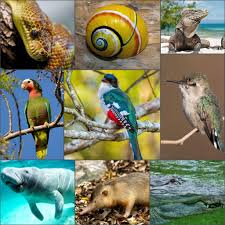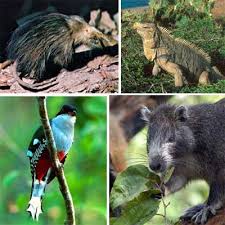
Cuba cuenta con una fauna diversa y única, con más de 15.000 especies. Esto incluye 42 mamíferos, 350 especies de aves, 121 reptiles, 46 anfibios y miles de insectos, moluscos y arácnidos.
Entre las especies de fauna cubana más destacadas se encuentran el cocodrilo cubano, la iguana de roca y la boa cubana. Si bien Cuba es un foco de biodiversidad, también enfrenta desafíos derivados de la introducción de especies y la pérdida de hábitat.
Sí, existen más de 15.000 especies animales en Cuba.
De hecho, se conocen más de 15.000 especies de fauna cubana, aunque la que vemos comúnmente en la vida cotidiana es importada.
En Cuba vive el pájaro más pequeño del mundo, el zunzuncito o pájaro mosca.
El zunzún (mellisuga elenae) es la más pequeña de las aves del mundo y mide alrededor de 6 cm de longitud como máximo y pesa como promedio alrededor de 2 gramos. Sólo vive en Cuba.
En Cuba vive el anfibio más pequeño del mundo.
Es la rana pigmeo o sapito (sminthillus limbatus) que mide menos de 12 mm de longitud.
En Cuba vive el murciélago más pequeño del mundo que a la vez se considera el menor de los mamíferos.
Se trata del Nystiellus lepidus o murciélago mariposa, que solo pesa 2-3 g y mide alrededor de 3 cms.
El almiquí, a punto de extinción, tiene la saliva venenosa. Efectivamente, el almiquí (solenodon cubanus) posee como característica de los mamíferos fósiles una saliva venenosa. Se pensó que estaba extinguido pues desde fines del siglo XIX no se veía pero en 1974 y 75 se capturaron 3 ejemplares.
Existen evidencias de que en Cuba vivieron monos.
El paralouatta varonai considerado el mayor de los monos antillanos sólo vivía en Cuba según se ha demostrado por hallazgos arqueológicos. Se desconoce cuando desapareció.
Que en nuestro país habitan 13 especies de jutía de las cuales algunas solo viven en determinados cayos.
Se han descrito 13 variedades de jutías en Cuba, algunas con un hábitat muy restringido lo que las hace peligrar. La jutía cabrera solo vive en el Cayo Ana María, la garrido en Cayo Majá, la jutía rata en Cayo Fragoso y la sanfelipensis en Cayo Juan García.
La jutía enana es la más pequeña de todos los del género capromydes en el mundo.
Dentro del género capromydes al cual pertenecen las jutías el representante más pequeño es la jutía enana, capromydes nana que solo vive en Cuba.
Se ha comprobado que en Viñales vive la especie de moluscos más antigua del mundo.
Se trata de la Viana regina o calcifolio que vive pegada a los mogotes y rocas para alimentarse del hongo de las mismas.
El manjuarí es considerado un fósil viviente y tiene cuerpo de pez y cabeza de reptil.
El manjuarí, atractosteus tristoechus, es un pez con características especiales, tiene cabeza similar a los reptiles y cuerpo de pez, su carne es comestible pero sus huevos son venenosos.

THE WORLD-RENOWN “CUBAN FAUNA” AND ITS GREATEST CURIOSITIES. PHOTOS.
Cuba boasts a diverse and unique fauna, with over 15,000 species. This includes 42 mammals, 350 bird species, 121 reptiles, 46 amphibians, and thousands of insects, mollusks, and arachnids. Among this fauna include the Cuban crocodile, rock iguana, and Cuban boa. While Cuba is a hotspot for biodiversity, it also faces challenges from introduced species and habitat loss.

Yes, there are more than 15,000 animal species in Cuba.
Indeed, there are well over 15,000 known species of Cuban fauna, although the one we commonly see in everyday life is imported.
Cuba is home to the smallest bird in the world, the hummingbird.
The hummingbird (Mellisuga elenae) is the smallest bird in the world, measuring approximately 6 cm in length and weighing an average of approximately 2 grams. It lives only in Cuba.
Cuba is home to the smallest amphibian in the world.
It is the pygmy frog (Sminthillus limbatus), which measures less than 12 mm in length.
Cuba is home to the smallest bat in the world, which is also considered the smallest mammal. This is the Nystiellus lepidus, or butterfly bat, which weighs only 2-3 g and measures about 3 cm.
The almiquí, on the verge of extinction, has poisonous saliva. Indeed, the almiquí (solenodon cubanus) has poisonous saliva as a characteristic of fossil mammals. It was thought to be extinct because it had not been seen since the late 19th century, but three specimens were captured in 1974 and 1975.
There is evidence that monkeys once lived in Cuba.
The Paralouatta varonai, considered the largest of the Antillean monkeys, only lived in Cuba, as proven by archaeological finds. Its extinction date is unknown.
There are 13 species of hutia inhabiting our country, some of which only live on certain keys.
13 varieties of hutia have been described in Cuba, some with very restricted habitats, making them endangered. The caprese hutia lives only on Cayo Ana María, the garrido hutia on Cayo Majá, the rat hutia on Cayo Fragoso, and the sanfelipensis hutia on Cayo Juan García.
The dwarf hutia is the smallest of all the Capromydes genus in the world.
Within the Capromydes genus, to which the hutias belong, the smallest representative is the dwarf hutia, Capromydes nana, which lives only in Cuba.
It has been proven that the oldest mollusk species in the world lives in Viñales.
It is the Viana regina, or calcifolio, which lives attached to the mogotes and rocks to feed on their fungus.
The manjuarí is considered a living fossil and has the body of a fish and the head of a reptile.
The manjuarí, Atractosteus tristoechus, is a fish with special characteristics. It has a reptile-like head and a fish-like body. Its meat is edible, but its eggs are poisonous.

Agencies/ MiPais/ CuriosidadesFauna/ InternetPhotos/ Extractos/ Excerpts/ Arnoldo Varona.
TheCubanHistory.com
THER CUBAN HISTORY, HOLLYWOOD.



